The 57th Annual Fox Valley Antiques Show
March 8th, 2014
|
Sam Scott of Denise Scott Antiques, East Greenwich, Rhode Island, is shown checking the drawer of a $1675 pine stepback open-top cupboard with original paint. Redware on the lower shelf ranged from a $145 bundt pan to a $65 pie plate and an $875 loaf pan.
Spring Hill Farm Antiques, Broadhead, Wisconsin, brought an array of mounted flagpole toppers priced at $45 to $75. The tallest is copper and had a sold sign. Others are aluminum. The game board was $95; the tin arch, $1200. The wooden street sign was $150. Note the stoneware paint mixing balls; priced at $10 each, they were used to agitate paint inside paint cans.
Volunteer Rod Faulkner of Hampshire, Illinois, was busy answering visitor questions about Garfield Farm, a historical site that the show benefits.
Viewers could not keep their hands off the $5885 miniature Chippendale desk from James Wm. Lowery Antiques, Baldwinsville, New York. Note the working slides for the writing surface. Lowery told us it was eastern Connecticut or Rhode Island, 1780-1800, and it came from the Fargo (of Wells Fargo) family. This was his first time at the show; both Lowerys seemed well pleased with traffic and results.
The Pennsylvania Amish quilt was $950 from Nancy and Craig Cheney of Mansfield, Ohio. The barber pole was tagged $795; the cat hooked rug, $595. The southern U.S. pitcher was $1750. Not seen but charming were five large painted farmstand signs labeling types of produce; they were $595 the lot. |
St. Charles, Illinois
Hope was touch and go for fans of early Americana as opening day for the Spring Fox Valley Antiques Show approached. The show is held biannually in St. Charles, a northwest suburb about an hour from Chicago, and produced by the Chicago Suburban Antiques Dealers Association (CSADA). This time it was scheduled for March 8 and 9. Already, over 79" of snow had fallen on the area, making the winter of 2013-14 Chicago’s third-biggest snow season since the late 1800s.
New snow threatened, but the gods of weather were kind; roads remained clear, so sellers and buyers could arrive. And arrive they did. According to show cochair Donna Finegan, the gate was “noticeably” above the previous show. Then, just to prove who was in charge, the gods dropped an additional 5" of heavy snow on the Wednesday following the show. As we arrived on Sunday, winter-weary flatlanders were streaming through the doors. On opening Saturday, a frigid day, CSADA served free coffee to early arrivals waiting in the show atrium for entry—nice touch.
Held in the main building of the Kane County Fairgrounds in St. Charles, the show has an enviable niche. Run by a long-established dealer organization founded in 1957 and peopled by dedicated volunteer members, the show has legs. This was the 57th spring show; October 2013 was the 39th fall show.
Specializing in antiques of the 18th century through early 20th century, the Fox Valley show is known as a place to find the best early merchandise. And it has built a client list to die for. This is a show where sellers come to establish relationships with buyers that last. When we asked one seller how his show was going, he remarked that he was still looking for one of his best customers, concluding sadly, “I’m afraid that he may have passed.” Not that this is a cliquey set. One seller from the East and new to the show confided that showgoers here are a chatty bunch, and yes, he’d had a great show. Three out-of-state sellers were first-timers to the event. There is a waiting list for both shows.
Visitors know their stuff and enjoy engaging sellers. Dealers at the show are known for passing along knowledge. It works both ways. There’s no chichi or posturing. At the show’s opening, “I was so busy in my booth that I could not look up until three p.m.,” cochair Tim Chambers told us. He specializes in visual folk art and Americana, and his sales were “incredibly consistent.” Seller Linda Armitage added, “When I looked down the aisle, I could not see anything but people. It was that crowded after open.” Calling visitors “definitely a knowledgeable group,” Chambers added, “We have a loyal contingent of buyers. People came and stayed for a long time. There was little thinning out, and we were still bustling during the last hours. We’ve always had a younger demographic, but for this show I’ve never seen so many strollers.”
Perhaps the youthful crowd happened because the area is populated by younger home buyers. Whatever the reason, it was a good sign. We also saw a remarkable number of school-age children, brought by parents who made a point of explaining items to their child. That’s another great sign. Donna Finegan overheard one youngster tell his mother, “It’s neat to see the old stuff.” We have to assume he wasn’t referring to dealers.
“I saw more furniture than usual going out, and that’s healthy,” Finegan reported. She sold furniture, including an 18th-century six-board blanket chest, plus “lots of good smalls.” A new buyer who collects shoes bought a pair of mid-1800s white high-top cloth shoes for a woman.
Show proceeds always go to area historical groups. CSADA contributes to historical societies, historic preservation sites, and history centers. For this show it was the Garfield Farm Museum (www.garfieldfarm.org). The farm museum is an 1840s historically intact 370-acre site being restored as a living history farm and tavern museum. Volunteers manned a farm display in the atrium, where we saw many visitors stop to ask questions and/or chat. The show brochure included many pages of area and Garfield Farm history.
CSADA’s fall show, set for October 18 and 19, is called Pioneer Spirit. Advance cards feature a brawny WPA mural in the post office of Glen Ellyn, Illinois, showing farm workers. For more information, see the Web site (www.csada.com).
|
|
|
|
|
|
Originally published in the May 2014 issue of Maine Antique Digest. © 2014 Maine Antique Digest



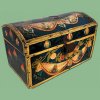
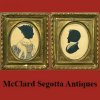


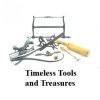










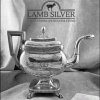


















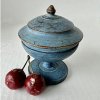

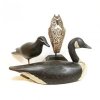


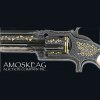








 We wanted to get a shot of Marion Atten with all her red sold signs before customers picked up their prizes. The Dewitt, Illinois, dealer’s 19th-century trencher was tagged $500; the 19th-century quilt was $675; and the 18th-century dough box was tagged $1800. All sold. She also sold apothecary drawers for $425 and a pair of wooden storage jars for $200, plus more. No wonder she pronounced the show “excellent.”
We wanted to get a shot of Marion Atten with all her red sold signs before customers picked up their prizes. The Dewitt, Illinois, dealer’s 19th-century trencher was tagged $500; the 19th-century quilt was $675; and the 18th-century dough box was tagged $1800. All sold. She also sold apothecary drawers for $425 and a pair of wooden storage jars for $200, plus more. No wonder she pronounced the show “excellent.” J & R Ferris Antiques, Boonville, New York, brought the $2150 eagle weathervane from a barn in Connecticut. Seller Scott Ferris dated it 1900-20s. The early 1800s leather fire buckets from the Boston area were $795 and $895. The oil on canvas of Lake George in 1942 at upper left was tagged $950.
J & R Ferris Antiques, Boonville, New York, brought the $2150 eagle weathervane from a barn in Connecticut. Seller Scott Ferris dated it 1900-20s. The early 1800s leather fire buckets from the Boston area were $795 and $895. The oil on canvas of Lake George in 1942 at upper left was tagged $950. Jason Sword’s atrium displays have been a treat for some five years. For this event, the theme of “Great Legs: Gams, Pins, Stems” was demonstrated with hanging furniture legs of all kinds. This was Sword’s swan song; come fall, CSADA will have a new atrium decorator.
Jason Sword’s atrium displays have been a treat for some five years. For this event, the theme of “Great Legs: Gams, Pins, Stems” was demonstrated with hanging furniture legs of all kinds. This was Sword’s swan song; come fall, CSADA will have a new atrium decorator.







